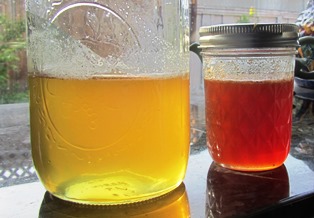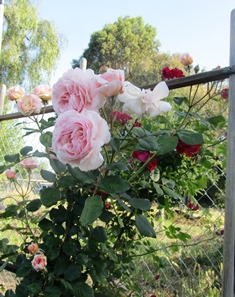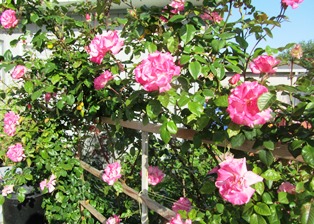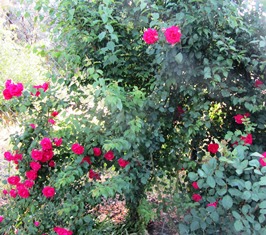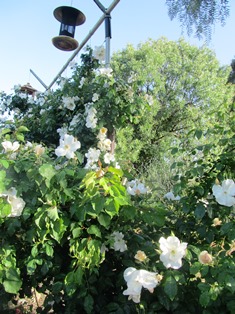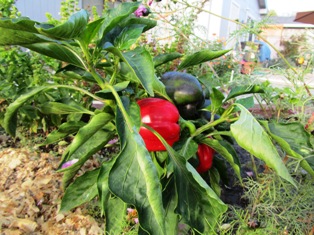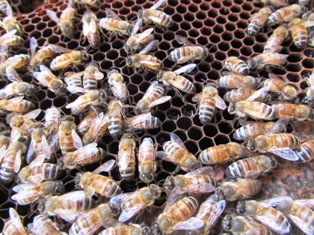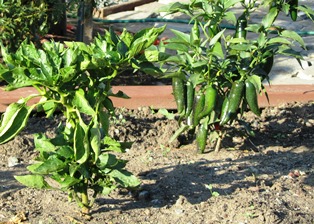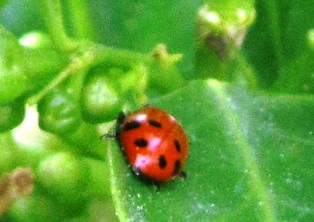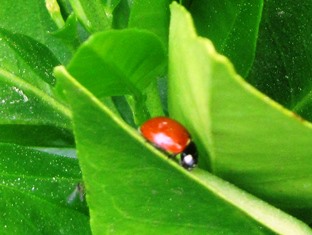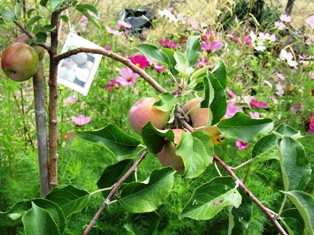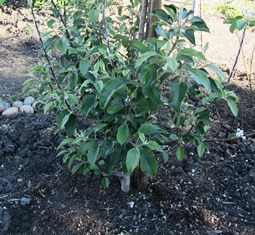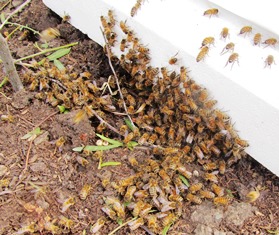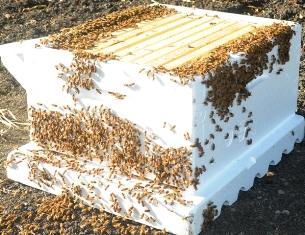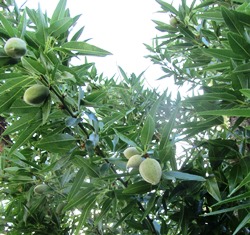Archive for April, 2013
Seasonal Flowers Change the Taste and Color of Honey
If you’ve ever wondered where honey gets its color and taste, think flowers. Or, more correctly, pollen from the flower and herb blooms and tree blossoms.
In the environs that encompasses roughly five to ten miles around the Henny Penny Farmette, honeybees gather pollen from blossoms on lavender, citrus, sunflowers, cosmos, fruit trees, and other flowering trees. Bees collect pollen from cultivated gardens but also from plants growing wild on hillsides and in the meadows and fields.
The first woodland flowers and wildflowers of spring yield honey that is a pale lemon color and tastes sweet and light. Later in the season, the pollen bees collect from citrus tree blooms such as orange blossoms becomes honey with citrus notes and aroma. When certain types of eucalyptus trees bloom in September, the honey takes on a warm amber color and a strong and earthy taste.
Dark honey is also found in a spring hive. It can be traced to the pollen that the bees have discovered and gathered from blossoms and blooms of flowers, trees, or herbs with a strong flavor and dark color.
If you want the health benefits from honey, purchase the raw honey. Raw honey is high in antioxidants and also has immune-boosting properties, according to Dr. Tasneem Bhatia, from the Atlanta Center for Holistic and Integrative medicine.
In a December 2012 appearance on the Dr. Oz show, Dr. Bhatia recommended people take 1 to 2 teaspoonfuls of buckwheat honey every day as a natural remedy for cold, sore throat, and flu symptoms. See, http://www.prweb.com/releases/honey/buckwheat-honey-raw/prweb10242276.htm
Raw honey means it has not been heated or otherwise adulterated by processes that reduce or compromise the healthy benefits. Beneficial enzymes, propolis, pollen, minerals, vitamins, amino acids, and antioxidants are destroyed when the honey is heated.
Drink your hot tea or warm milk with honey, but don’t put the honey in the cup of liquid and stick it into the microwave. Warm the liquid first, then add the honey.
It matters not whether your taste leans toward the light honey or the dark, the liquid honey or the honeycomb, have some honey every day. It’s good for you.
Climbing Roses Put On a Show for Spring
I confess I’m a rose lover. This time of year, the climbing roses we’ve planted are clambering up on wooden trellises, chain link fences, and even the wall of the chicken house, putting on a spectacular display. What’s not to love?
Here in Northern California’s inland valleys, these climbers offer their most magnificent displays of color, shape, texture, and scent during spring. Most do well with a season-long balanced fertilizer, water, and pruning to remove dead canes and spent flower heads. Mulch with organic matter to conserve water and keep down the weeds.
Climbing Handel features cream-colored blooms, edged in a rose shade of pink. It is hardy, has glossy green foliage, and upright pillar growth.
Climbing Don Juan grows upright and has a tendency to spread out. Its canes produce red flowers that are 3 to 6 inches in diameter. The plant blooms from spring until frost.
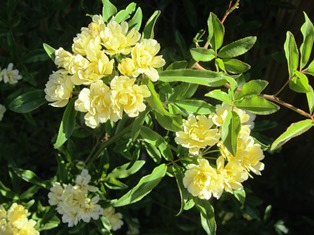
Lady Banks is a species rose named after the wife of Sir Joseph Banks, legendary head of the Royal Horticultural Society of Great Britain
Climbing Lady Banks scampers up our chicken house wall and explodes into a profusion of hundreds of disease-resistant yellow roses on long canes without thorns. This rose is not a hybrid, but rather comes from China and has been cultivated since 1796. To say it spreads is an understatement–the largest Lady Banks grows in Tombstone, Arizona where it covers 8,000 square feet.
Climbing Sally Holmes is a showoff in our garden. The pointed-shaped buds start out cream-colored (tinged in pink) and then open into an white bloom with a light, sweet fragrance. The rose can climb 12 feet, the height ours has reached where it grows along the back fence.
The vigor of Sally Holmes means it can easily be grown from cuttings. In fact our massive climber was grown from an arm-length cutting dusted with root hormone that we stuck in the ground three years ago. We’ve taken many cuttings since to start the climber elsewhere on our property.
If you have the space for climbers, consider giving one or more a try. Although they are hardy, often disease-resistant, and reward with spectacular displays of bloom, they need support, so think pillars, arbors, gazebos, porch railings, and fences.
Making A Flower Essence In Eight Easy Steps
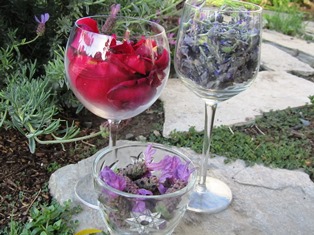
Rose petals, Spanish lavender, and French perfume lavender each can be used to make a flower essence
Although flower essences technically are not made for scent or perfume, some flowers carry their scent along with their subtle energy vibration that is stored in the flower petals used to create the essence. Flower essences can be used in aroma therapy or as a tincture that can be consumed for health and well being.
Flower-derived essential oils provide potent scent, but I’ve made flower essences (not essential oils) that also offer scent. You can, too. The process is simple and involves eight steps.
You’ll need bottles (sterilized) with stoppers or caps, tweezers (to pluck flower petals), glass bowls to hold the petals, sterile spring water, and brandy (as preservative).
Because you don’t want to introduce any contaminants into the essence, do not use your fingers to touch (contaminate) the petals, water, or brandy during the process.
Use only organically grown flower petals that you’ve gathered during the early morning hours when your flowers are freshest. Sterilize the stopper bottles in boiling water.
Using your tweezers, pluck the rose petals, lavender tips, or other flowers. You can mix rose varieties, but don’t mix rose petals with other flowers. Note: the Spanish lavender scent is slightly different than the French perfume lavender.
Step 1. Gather your petals or flower heads and put them into a glass container (bowl or large mouth wine glass).
Step 2. Add the sterile water to cover.
Step 3. Place in direct sunlight (cloudless days in spring and summer are best) and leave for at least 3 hours.
Step 4. Use tweezers to remove the flowers and any debris from the water.
Step 5. Fill your special stopper bottles half full with brandy.
Step 6. Pour the flower water to fill the bottle to the neck.
Step. 7. Seal the bottle with a stopper and label the bottle with the type of flower essence and the date.
Step 8. Shake the bottle gently several times. Now your flower essence is ready to use.
Rose essence (like a rose essential oil used in aroma therapy) can balance the emotions, while lavender is considered a stress reducer.
The BGW of Composting
Perhaps you’ve wanted to try composting but are concerned about not knowing the ABCs. Forget the ABCs. Try remembering three other letters: B for brown, G for green, and W for water. Those are the three key ingredients of any successful compost pile.
The B (brown waste) includes twigs, branches, and dead leaves. The G (green material) is made up of fruit and vegetable scraps, grass clippings, and coffee grounds, among other things. The W (water) adds the necessary moisture.
The brown material provides carbon, the green material provides nitrogen, and the water creates the magic, turning that brown and green stuff to turn into that dark, crumbly, earthy compost that worms and garden plants love.
If you are like many gardeners, you might pay for compost purchased in bags at local nurseries. But keep in mind that food scraps and yard waste make up about one-third of the material that goes into landfills. Put that material into a compost pile and it saves you money in several ways.
Using compost in your garden reduces water usage because the compost keeps the roots of plants moist and cool. Reduced water usage lowers your water bill and leaves more money in your pocket. Your compost material enhances the richness of your soil while keeping down weeds. Your garden thrives, meaning you won’t have to spend as much on fresh produce if you are growing your own.
You can make a simple bin out of galvanized chicken wire. Stretch the chicken wire into a cylinder shape. Stick some posts in around the circle to hold the wire up and in position. And start throwing in the brown and the green waste, plus some water. Turn every so often.
Once you know the BGWs of composting, there’s really no reason not to try it. Composting not only saves you money, it helps our planet.
Learning about GMO Food Safety
You might assume your zucchini and sweet corn is safe to eat but what if it was grown from GMO-treated seed, able to withstand an herbicide or even produce an insecticide as it grows? What happens in your gut when you eat that corn? What happens to animals fed such corn? These are questions that scientists, doctors, consumers, food safety advocates, and environmentalists all grapple with in their concern about GMO food safety.
The Non-GMO Project is a nonprofit organization concerned with GMOs and food safety. It explains on its Web site that a genetically modified organism (GMO) is a plant or animal that has been “genetically engineered with DNA from bacteria, viruses, or other plants and animals.” That means it is an anomaly in nature as such experimental combining of genes of different species does not occur in traditional crossbreeding or in nature (http://www.nongmoproject.org/learn-more).
Consumers might not be getting all the facts of what is known and what science is discovering about the health concerns of many Americans eating foods that contain GMOs. Estimates suggest that 80 percent of U.S. processed foods contain GMOs, meaning millions of Americans are eating foods that might not be all that safe to consume. Research into links between GMO consumption and ill health are ongoing but already GMO-altered foods, whether plants or animals, are raising health concerns.
Seed suppliers say that interest in non-GMO corn seed is growing among farmers because of lower costs, better animal health, and higher yields as well as increasing disenchantment with genetically modified traits of GMO seed (http://www.non-gmoreport.com/articles/january2013/Demand-growing-for-non-GMO-corn-seed.php)
With summer on the horizon, many people are planting seeds or seedlings in their gardens or are anticipating the plentiful vegetables available at produce stands and in supermarkets. But read the labels on all those mounds of squash, tomatoes, peppers, and potatoes.
Potatoes and tomatoes are considered low-risk for GMOs by the Non-GMO Project, that is, those two vegetables are not currently being genetically engineered. Although many people might think wheat is a concern, the Non-GMO Project states that wheat is not now nor ever has been genetically engineered, unlike soy, cotton, sugar beets, alfalfa, canola, zucchini, and summer squash.
More than 60 countries, including most of the developed nations, have banned or restricted GMOs. The United States is the exception, allowing production and sale of such products to continue. Consumers, scientists, and environmentalists opposed to genetic manipulation of plants and animals say avoidance and boycott of such products are consumer choices even as legal battles against bio-tech giants and anti-GMO advocates move through the courts.
As for summer corn, the best option might be to grow your own from heirloom seed that has not been genetically maniuplated. Otherwise, buy corn certified as non-GMO or from sources that support organic farmers and food sources such as Whole Foods and other organic markets. Check out the offerings for seed at Seeds Now (http://www.seedsnow.com/pages/shop-all-seeds).
Getting Stung Is No Fun!
Working outside in my garden, I heard a loud buzz next to my ear and felt a searing pain at the site where my cheek and ear meet. I wouldn’t swat at the bee. I didn’t actually see it. But, boy, did I feel it!
I dashed into the house and my husband removed the stinger. I put an ice cube into a napkin and rubbed the site for a few minutes until the pain subsided. I also took a an antihistamine tablet with diphenhydramine, the active ingredient in Benadryl™.
Here are a few helpful tips if you or someone you know gets stung.
Remove the stinger as soon as possible. The longer the stinger is left in place, the more venom is injected. Use your fingernail or tweezers to get it out.
The application of ice will keep down the swelling. For people over 18 with pain from a bee sting, give acetaminophen or ibuprofen.
Antihistamines can help with the itchiness associated with a bee sting.
For severe reactions or for people allergic to bee stings, seek immediate emergency assistance. Symptoms can include difficulty breathing. rapid heartbeat, tightness in the throat, hoarseness, and anxiety.
If the person stung has a history of anaphylaxis and possesses a doctor-prescribed emergency dose of epinephrine, have him inject the dose or do it for him if the individual cannot.
Experiment with New Varieties of Tomatoes and Peppers
Tomatoes are one of my favorite plants from the summer garden. So it’s not surprising that of all the seed catalogs that I get each spring, the Tomato Growers catalog is one of my favorites. It offers 60 full-color pages of mostly tomatoes, but also peppers and eggplant varieties, a listing of equipment and supplies (for example tomato strainers), and books for gardeners. See, http://www.tomatogrowers.com/
I voraciously read all the catalog copy about each type of tomato and pepper and then note the seeds I want to grow. Experimenting with different varieties enables me to experience new flavors, new textures, and other unique characteristics of each variety.
In early spring when my neighbors rush off to garden centers for seedling tomatoes shipped to local nurseries by growers, I begin the process of planting my tomato and pepper seed in cell flats. The flats remain in the warm kitchen until the plants have emerged and have four sets of leaves. Only then do I place them in the garden to allow them time to acclimatize (harden off).
Removing the plants from their cell packs, I plant the seedlings in a basin or hole with native soil mixed with chicken manure or vegetable food. In that basin, the tomatoes benefit from the warmth of the sun and deep watering after transplanting. I do not plant the peppers in basins.
Stressing the tomato plant by withholding water yields tomatoes higher in flavor but can reduce the size and quantity. Too much water, however, can leach nitrogen and other nutrients from the soil and cause the plant to produce lots of leaves but fewer blossoms and fruit.
Near the heat-loving tomatoes in my garden, I always tuck in a few bell peppers, pickling peppers, and hot chili peppers. The Serrano peppers are pungent like jalapeno peppers and measure roughly 5,000 Scoville units of heat. Other peppers such as the Trinidad Perfume and the Fooled You peppers have no heat but are prized as seasoning for dishes requiring peppers.
A word of caution about growing tomatoes. Don’t plant them in the same area of your garden more than three years in a row. Experts say move them around as tomatoes are heavy feeders and putting them in depleted soil or soil in which you’ve grown tomatoes that have become sick can infect your new plants.
If you are interested in the pros and cons of dry farming tomatoes (meaning reduced watering) for intensive flavor and higher sugar content, check out the interesting article on the Growing For Market newsletter. See, http://www.growingformarket.com/articles/Improve-tomato-flavor
The Farmette Welcomes a Proliferation of Ladybugs
Ladybugs, of late, are proliferating all over the Henny Penny Farmette and on my neighbors’ properties as well. On Sunday afternoon, the young daughters of a neighbor and I spent a lovely hour plucking ladybugs from the grass, placing them upon our hands, and watching them zip up and down our arms.
Ladybugs are beneficial to the gardens. It’s been estimated that during its life that lasts about a year, the average ladybug will consume 5,000 aphids, those soft-body pests whose larvae that dine on tender, young plant shoots.
Of the thousands of species of ladybugs in the world, only about 175 are found in California. By far, the Convergent Lady Beetle is most common and highly beneficial to California gardens.
The various varieties of ladybugs and other beneficial insects can keep in check populations of harmful pests so gardeners won’t have to resort to using insecticides and pesticides. A healthy, strong ecosystem is always best for organic gardens.
Female ladybugs are often larger than their male counterparts, depending on the species. Some have spots and some don’t. Their color isn’t limited to just red and orange, but can include a host of other hues. To learn more about ladybugs, see http://www.everything-ladybug.com/ladybug-facts.html.
A daily stroll around the farmette that includes a ladybug sighting tends to make me smile. I might even be heard whispering words of welcome. With the ladybugs here, I feel reassured that my organic fruits and vegetables are a little safer from the dreaded aphids.
Mulching Do’s and Don’ts
An area of the garden where we planted apple trees two years ago had become so overgrown with weeds that it required many hours of weeding.
Following the weeding, we added organic mulch. I like to create an area as large as the canopy of the tree around the base of the tree (free of any plants or weeds) so that I can easily feed and water our fruit trees throughout the growing season. Then I reapply the mulch.
Mulching with organic material makes it easier to prevent the germination of weeds, facilitate watering and feeding of the fruit trees, encourages the proliferation and activities of earthworms (good for improving the soil), and keeps the soil moist (reducing the amount of water needed).
When adding organic mulch to the top of the soil, the keep in mind the following tips.
1. Do dig in high-nitrogen products such as chicken manure, blood meal, or cottonseed meal into the soil around the plant or tree before layering atop the soil low-nitrogen mulch such as bark, wood chips, or decayed sawdust material.
2. Do pull mulch back from over bulbs and perennials in the spring to facilitate a faster start to their warming and growth cycle.
3. Be aware of snails and slugs that can hide in damp mulch. Try placing a layer of newspaper where you think the snails and slugs might be proliferating. Put the paper down on the soil at night and retrieve it before sunup when you can turn it over to see the pests clinging to it. Dispose of the newspaper in the garbage.
3. Don’t mulch too close to the stems of shrubs or trees s since wet mulch and cause stem rot; ensure that the mulch is at least an six inches away from a shrub stem or tree trunk.
4. Don’t pile mulch too deep; doing so encourages rodents such as voles, rats, and mice to use the mulch for nests.
Beekeepers File Suit to Ban Two Pesticides
Neonicotinoid pesticides pose a high risk to honeybees, a belief that has beekeepers aligned with environmentalists and scientists and is the basis of a lawsuit filed against the Environmental Protection Agency.
According to the EPA’s website, several European countries have suspended or banned the use of neonicotinoids (commonly referred to as neo-nics) for causing acute poisoning of honeybees. However, the EPA denied the request posed in a legal petition by environmental organizations and beekeepers in 2012 here in America to ban clothianidin, an insecticide classified as a neonicotinoid.
Recently, the Center for Food Safety, on behalf of commercial beekeepers and environmental organizations, filed suit against the EPA seeking to force the EPA to suspend the use of the insecticides clothianidin and thiamethoxam. Both insecticides are are neonicotinoids, a class of chemicals that harm the nervous system of bees.
Healthy bees are vital for the pollination of California’s almond crop (the state produces roughly 80 percent of the world’s almonds) but also bees are necessary for the pollination of roughly 30 percent of other crops in the United States.
When the almond orchards of California need honeybees for pollination, they turn to the commercial beekeepers, many in the Midwest. It is estimated that more than half of the nation’s honeybees are shipped in their hives here for the almond blooming season–possibly the nation’s largest pollination event. This year, there was a shortage of bees.
With higher than usual die-offs of bees and colony collapse disorder (in which, bees disappear or die) on the rise, beekeepers and scientists have long suspected that the chemicals in certain pesticides play a role. Exposure to chemical residue in nectar, pollen, and dust (from treated seeds) not only hurt the honeybees, but some say also affect other beneficial insects.
The EPA states on its Website <http://www.epa.gov/opp00001/about/factsheets/protectbees_fs.html> that it is working toward pollinator protection on several fronts, including through regulatory, voluntary, and research programs.
Although the EPA is re-evaluating the use of neo-nics, the agency’s re-evaluation process will not be completed anytime soon–it can take years. That could be bad news for the nation’s beekeepers and California’s almond growers.
 Facebook
Facebook Goodreads
Goodreads LinkedIn
LinkedIn Meera Lester
Meera Lester Twitter
Twitter






